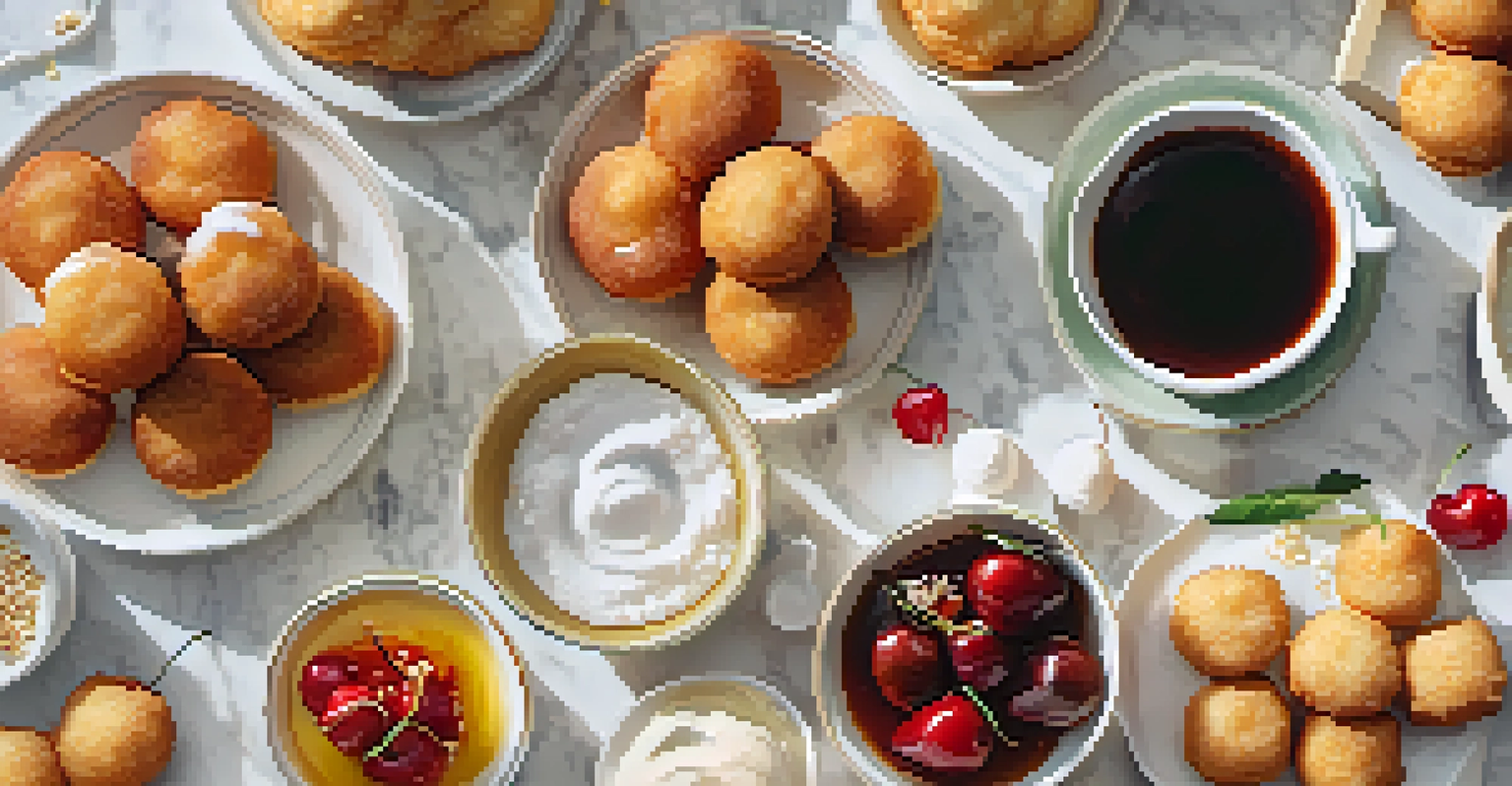Beignets: Sweet Treats and Their Cultural Importance

What Are Beignets? A Delicious Overview
At their core, beignets are deep-fried pastries, often dusted with powdered sugar. Originating from French cuisine, they have a light, airy texture that makes them a delightful treat. Traditionally, they are square or rectangular in shape, making them instantly recognizable and a favorite at many cafes.
Food is our common ground, a universal experience.
While they may seem simple, beignets can be filled with a variety of delicious options, like fruit preserves, chocolate, or even cream. This versatility allows them to cater to diverse tastes, making them a beloved snack across different cultures. Whether enjoyed plain or stuffed, each bite promises a burst of sweetness.
In essence, beignets are more than just a pastry; they are a canvas for creativity in the kitchen. Their delightful flavor and texture make them a staple at brunches and celebrations, captivating the taste buds of many.
A Brief History: From France to the World
The history of beignets traces back to the 16th century in France, where they were initially made by frying dough in hot oil. The name 'beignet' actually translates to 'fritter' in French, highlighting its fried origins. Over time, these pastries made their way to New Orleans, where they became an integral part of the local cuisine.

In New Orleans, beignets were embraced wholeheartedly, especially during Mardi Gras. Cafés began serving them as a traditional treat, and they quickly became synonymous with the city's festive spirit. The iconic Café du Monde, established in 1862, is perhaps the most famous spot to enjoy these sweet delights.
Beignets: A Cultural Delight
Beignets are more than just pastries; they symbolize celebration and community, particularly in New Orleans.
Today, beignets have transcended their French roots, becoming beloved in various cultures worldwide. From street vendors in Vietnam to gourmet restaurants in the United States, their journey reflects a beautiful blend of culinary traditions.
Cultural Significance: More Than Just a Snack
Beignets hold a special place in the hearts of many, symbolizing celebration and joy. In New Orleans, they are not only a delicious treat but also a cultural staple that brings people together during festivities. Sharing a plate of beignets can turn a simple gathering into a memorable occasion.
Cooking is like love. It should be entered into with abandon or not at all.
Their association with events like Mardi Gras underscores their importance in community bonding. During this lively festival, beignets are often enjoyed alongside coffee, creating a delightful experience that enhances social interactions. It's a beautiful reminder of how food can foster connections.
Beyond New Orleans, beignets are embraced in other cultures, each adding unique twists. From Vietnamese 'bánh tiêu' to Italian 'zeppole', these variations showcase how a simple fried pastry can take on different meanings and significance in diverse cultural contexts.
How to Enjoy Beignets: Best Pairings
While beignets are delicious on their own, pairing them with the right beverages can elevate the experience. A classic choice is a cup of café au lait, a rich blend of coffee and steamed milk, which complements the sweetness of the pastries perfectly. This pairing is a staple in many New Orleans cafés.
For a refreshing twist, consider enjoying beignets with a chilled glass of iced tea or lemonade. The tartness of these drinks balances out the sugary sweetness of the beignets, creating a delightful contrast. This combination is particularly popular during warmer months.
Global Variations of Beignets
From 'zeppole' in Italy to 'bánh tiêu' in Vietnam, beignets have inspired diverse adaptations around the world.
Don’t shy away from experimenting with other pairings, like hot chocolate or even a fruit smoothie. The key is to find flavors that harmonize with the pastries, making each bite and sip a joyous experience.
Making Beignets at Home: A Simple Recipe
If you're feeling adventurous, making beignets at home can be a fun and rewarding experience! The basic ingredients include flour, sugar, yeast, and a touch of milk. Once you mix the dough and let it rise, the process of frying them is where the magic happens.
Start by rolling out the dough and cutting it into squares before frying them until golden brown. Once they’re done, all that's left is a generous dusting of powdered sugar on top. The aroma wafting from your kitchen will surely entice anyone nearby to join in the fun.
Making beignets at home also allows for creative freedom. You can experiment with different fillings or toppings, tailoring the treat to your personal taste. Whether you go for traditional or innovate with flavors, the key is to enjoy the process and, of course, the delicious result.
Beignets Around the World: Global Variations
As we’ve seen, beignets have inspired many global variations, each with its own unique twist. In Italy, for example, 'zeppole' are often filled with cream and adorned with cherries, making them a festive treat during celebrations. These pastries showcase how different cultures adapt and embrace the concept of a simple fried dough.
In Vietnam, 'bánh tiêu' features a slightly different preparation, often incorporating sesame seeds and served with a sweet dipping sauce. This variation highlights the versatility of beignets, which can take on flavors and textures distinct to the region.
Enjoying Beignets at Home
Making beignets at home is a fun experience that allows for creativity with fillings and toppings.
These adaptations not only demonstrate the global love for beignets but also serve as a reminder of the interconnectedness of culinary traditions. Every culture brings its own flair, making beignets a beloved treat worldwide.
Conclusion: The Sweet Legacy of Beignets
In conclusion, beignets are not just a treat; they represent a rich tapestry of culture, history, and community. Their journey from France to the bustling streets of New Orleans and beyond showcases the universal love for this delightful pastry. Whether enjoyed at a café or made at home, beignets continue to bring joy to those who indulge in them.
As we savor each bite, we can appreciate the stories and traditions behind these sweet treats. They remind us of the importance of sharing food and experiences with loved ones, creating cherished memories around the table.

So the next time you indulge in a beignet, take a moment to reflect on its cultural significance and the joy it brings. After all, life's sweetest moments are often best enjoyed with a pastry in hand!